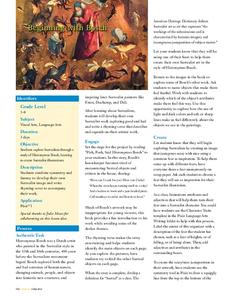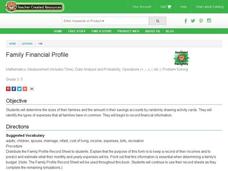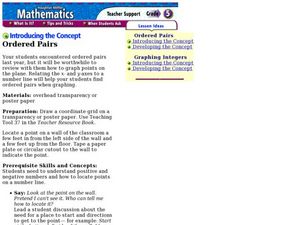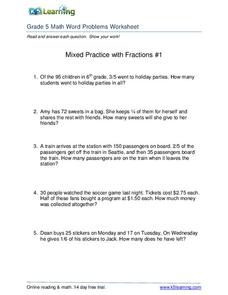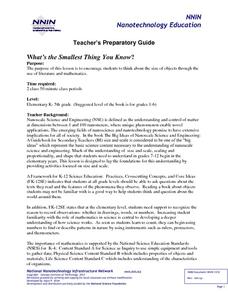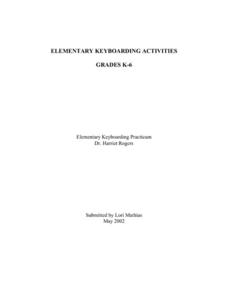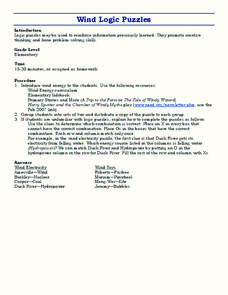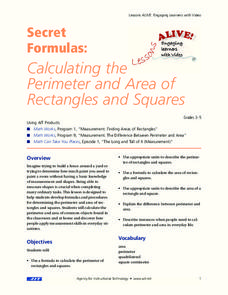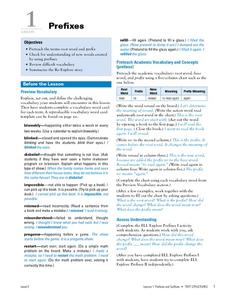Curated OER
Ratios, Proportions and Percents
Fifth graders complete 3 activities centered around percents. In this ratios, proportions and percents lesson, 5th graders create designs on grid paper that illustrate a variety of percents, solve percent problems mentally, and use...
Curated OER
Migration of the Neo-Tropical Songbirds
Fifth graders plot the migration of birds using Google Earth. For this lesson on bird migration, 5th graders work in groups to plot the migration of a group of birds using Google Earth. Students present and discuss their findings and...
Curated OER
Beginning with Bosch
Students become familiar with surrealism through the artwork of Hieronymus Bosch. In this Bosch lesson plan, students explore symmetry and surrealism. Students create step by drawings on the computer in the style of Hieronymus Bosch....
Curated OER
Explore the Ocean
Students explore the oceans from their origin. In this oceans lesson, students read and discuss excerpts from the Book of Genesis regarding the creation of the ocean. Students then clean up a mock oil spill, measure the volume and area...
Curated OER
Family Financial Profile
Students investigate the cost of living. In this financial awareness lesson, students play a game to simulate various family situations and their incomes. Students choose activity cards and record information on their family profile...
Curated OER
Grand Canyon History Lesson
Students explore the history of the Grand Canyon. In this Grand Canyon lesson, students read "Grand Canyon National Park" by David Peterson and respond to questions regarding the piece. Students also create their own fossil models that...
Curated OER
I'm done! Now, what can I do in Math?
Here are some ways to avoid having bored students or a stressed out teacher when students finish their math work quickly.
Curated OER
Introducing the Concept: Ordered Pairs
Learners review ordered pairs. In this graphing lesson, students review ordered pairs with the teacher. This lesson includes a brief teacher script to help guide the learners in understanding.
K5 Learning
Mixed Practice with Fractions
Help young mathematicians see how fractions are used every day in the world around them with a series of problem solving exercises. Offering eight different word problems, this worksheet challenges children to apply their...
Computer Science Unplugged
Twenty Guesses—Information Theory
How do we determine how much information to include and what can be left out? By playing a game of 20 questions, the class generates the best strategies for finding a number. They then move on to guessing the next letter in a short...
National Nanotechnology Infrastructure Network
What’s the Smallest Thing You Know?
Elementary learners listen to a story, then sort objects from largest to smallest at six different stations around the classroom. Adaptable for a large range of age and ability groups.
Curated OER
Human Body Lessons
Students read "The Magic School Bus in the Human Body" and discuss the importance of maintaining a healthy body. They create a hinge and joint paper skeleton, follow the journey of a hamburger through the digestive tract, jump rope and...
Curated OER
Elementary Keyboarding Activities
Listen to the sound of children's fingers flying across their keyboards as they perform these fun typing lessons. From creating alphabet books and multimedia presentations to researching presidents and writing class...
Curated OER
Earthquakes: Fifth Grade Lesson Plans and Activities
After learning about P waves and S waves, fifth graders view the intensity of earthquakes by examining seismographs and images of earthquake damage. Young scientists then forecasting future quakes by analyzing data about...
Curated OER
Plate Tectonics: Fifth Grade Lesson Plans and Activities
Fifth graders continue their investigation of the plate tectonics cycle with an exploration of the movement of Earth's crust. During the lab, young geologists conduct an experiment to discover the result of different types of...
Curated OER
Wind Logic Puzzles
Students listen to books on wind energy for background knowledge. In this wind logic puzzle, students use knowledge of wind energy and critical thinking skills to complete logic puzzles. Students may work in groups or individually as...
Curated OER
Secret Formulas
Learners calculate the perimeter of rectangles and squares. They imagine trying to build a fence around a yard or trying to determine how much paint they need to paint a room. They also develop formulas and procedures for determining the...
Baylor College
Moving Air
In lab groups, young scientists place aluminum cans with a bubble-solution cap into different temperatures of water to see what size of bubble dome forms. As part of an atmosphere unit in preparation for learning about convection...
Curated OER
Multiplication Facts up to 10 X 10
Here is a presentation that's chock full of great tips on how to memorize multiplication facts, and how to calculate the area of shapes that aren't perfect squares or rectangles. Many good problems are in each of the slides. A great...
Creative Educator
Fantastic Fractions
Groups of learners create an animation illustrating fractions using common objects. They choose everyday objects that they can divide into fractions. They take pictures of the objects dividing into fractions and create an animation with...
Perfection Learning
Prefixes, Suffixes, and Root Words/Base Words
Get your class on track with their affixes by covering prefixes, suffixes, and root words in depth. This short three-lesson unit includes vocabulary lists to study, detailed plan procedures, and some accompanying worksheets.
Baylor College
About Air
Give your class a colorful and tasty representation of the components of the mixture that we call air. Pop a few batches of popcorn in four different colors, one to represent each gas: nitrogen, oxygen, argon, and carbon dioxide. The...
Curated OER
"Math Curse" by Jon Scieszka
Students explain everyday uses of numbers and relationships of numbers.
Curated OER
The Foot Book
Young scholars use estimation and measurement skills to make predictions and solve problems about length. They also analyze data presented to calculate ratios and percents.


